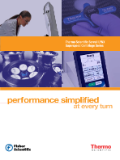Centrifuges and Microcentrifuges
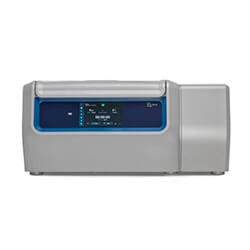
Centrifuges and microcentrifuges are commonplace in laboratories. They are used to separate solutions using the centrifugal force created by the rotor moving on a fixed axis. Successful sample centrifugation depends on the density, temperature, and viscosity of the sample and solution, and the speed of the rotation.
Read More About Centrifuges and MicrocentrifugesTop Categories
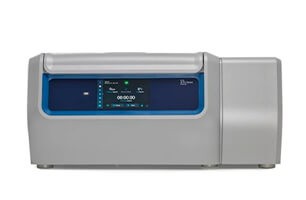
Quick, Easy Access
Benchtop Centrifuges
Designed for immediate access from your benchtop. Available in ventilated, refrigerated, or heated varieties, with or without rotors.
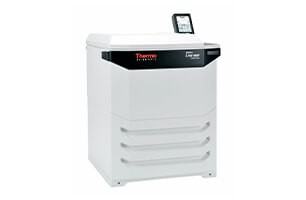
High Throughput and Speed
Floor Model Centrifuges
Stand-alone centrifuge models can operate at faster speeds and come in larger capacities.
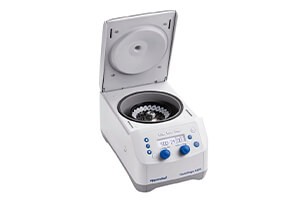
Compact for a Smaller Footprint
Microcentrifuges
Ideal for small sample sizes less than 5.0mL and have ventilation or refrigeration capabilities.
Featured Products
Thermo Scientific Sorvall Legend and ST General Purpose Centrifuge Series Brochure
Thermo Scientific Sorvall general purpose centrifuges fit in to your space with compact designs and stand out with innovative Thermo Scientific technologies, including AutoLock rotor exchange, ClickSeal biocontainment lids and Fiberlite carbon fiber rotors.
Thermo Scientific LYNX Super Speed Centrifuge Brochure
Exceptional performance, reliability and safety with this simple, yet high-throughput sample processing.
Thermo Scientific Fiberlite Carbon Fiber Rotors Brochure
Thermo Scientific Fiberlite Rotors maximize centrifuge performance with versatility, speed and a robust corrosion-free design.
Auto-Lock Rotor Exchange
Achieve secure, push-button rotor exchange in as little as three seconds with Thermo Scientific Auto-Lock Rotor Exchange in Thermo Scientific Benchtop Centrifuges.
More
Thermo Scientific Sorvall WX+ Ultracentrifuge Series
Discover how to overcome the everyday challenges of a shared laboratory setting with up to 100,000 rpm performance in a small footprint to maximize space in your lab.
Fiberlite Rotors for Benchtop Applications
Learn more about the outstanding ergonomics and performance of Thermo Scientific Fiberlite Carbon Fiber Rotors for Thermo Scientific General Purpose Centrifuges.
Unmatched Capacity, Remarkably Small Footprint
Outstanding capacity in a compact design that fits in to your lab’s space and stands out with Thermo Scientific innovative technologies such as Auto‐Lock rotor exchange. With a space-saving design, small benchtop centrifuges provide support in both clinical and research applications.
Thermo Scientific Sorvall MTX and MX+ Micro-Ultracentrifuge Series
Designed to deliver excellent performance with RCF up to 1,048,000 x g and versatility for rapid small-volume processing applications, our Thermo Scientific Sorvall MTX and MX+ microultracentrifuges feature advanced functionality in a compact footprint.
Thermo Scientific Sorvall Legend Micro 17 and 21 Microcentrifuge Series Brochure
Micro 17 and 21 microcentrifuges fit in with compact footprints, and stand out with user-friendly features, the unique dual-row rotor and Thermo Scientific ClickSeal biocontainment lids.
Certified Biocontainment with ClickSeal Lids
One-handed, certified sample protection with ClickSeal biocontainment rotor lids eliminates multiturn screw caps and complicated high pressure clips. Glove-friendly with one-handed open/close capability and ergonomically designed for both right- and left-handed operation.
Centrifuge Innovations for the Clinical Lab
Discover how Thermo Scientific Benchtop Centrifuges can support your clinical applications.
Quick, Secure Auto-lock Rotor Exchange
Enjoy the ability to quickly switch between applications, and the flexibility to evolve with the changing needs of your laboratory. Push-button rotor installation and removal in only 3 seconds shortens run set-up time.
ClickSeal Biocontainment Lids
Enjoy one-handed, sample protection with Thermo Scientific ClickSeal Biocontainment Lids for Thermo Scientific Benchtop Centrifuge Rotors.
Thermo Scientific Fiberlite Carbon Fiber High Speed Rotors
Lightweight, corrosion-resistant Fiberlite carbon fiber rotors improve ergonomics and performance. Enjoy a complete workflow in one conical tube along with a speed handle which simplifies lid tightening or removing.
Operation Simplified at Every Turn
Built-in safety and ergonomics – from the non-bolt down design, to the hands-full door opening. Optimized for everyday centrifuge use and speed handle simplifies lid tightening or removal. Meets the latest global safety standards and is a certified biocontainment.
Performance Simplified at Every Turn
Performance is simplified at every turn with Thermo Scientific Sorvall LYNX superspeed centrifuges. A versatile, high-throughput sample processing system with the ability to meet evolving application needs, from academic research to production facilities.
Introducing the NEW! Thermo Scientific Sorvall LYNX Superspeed Centrifuge
To overcome the everyday challenges of a shared laboratory setting choose the NEW! Thermo Scientific Sorvall LYNX superspeed centrifuge. Take advantage of push-button security and application flexibility along with improved ergonomics and performance.
Intuitive Touch-screen Interface
Simple and quick run set-up with a large, bright, interactive touchscreen for all centrifuge functions and durable for use run after run, year after year. Create up to 99 programs with alpha-numeric naming along with an integrated rotor calculator for simplifying protocol modifications and transfers.
Simple Yet Powerful Touch-Screen Interface
Touch-screen interface with bright, durable display simplifies run set-up. Highly visible backlit display of set and actual run conditions, enlarged during the run for clear visibility — even from across the lab. Convenient virtual touchscreen keyboard for direct input of program parameters.
Auto-ID Instant Rotor Identification
Realize an immediate identification of a rotor when secured in the centrifuge chamber, with rotor specifications automatically loaded into the centrifuge parameters. Eliminates over-speed risk, reduces error messages, and improves centrifuge, sample and operator safety.
Extensive Rotor Portfolio for Evolving Research Needs
Our extensive rotor portfolio provides application flexibility for years to come. Supports multiple users and evolving research needs — from microtubes up to 1L bottles. Lightweight carbon fiber and innovative construction allow unique rotor designs not possible with metal.








